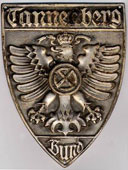Tannenbergbund
The Tannenberg-Bund - Arbeitsgemeinschaft völkischer Frontkrieger- und Jugendverbände (TB) was a völkischer association, which was formed mainly from front-line fighters of the First World War . It was named after the battle of Tannenberg in the First World War. It was founded on September 5 or 7, 1925 with the decisive involvement of the later Reich Labor Leader Konstantin Hierl , who was officially only the state director of Bavaria, but who actually worked as the organizer of the TB throughout Germany. Erich Ludendorff formally only took over the patronage, but the TB is to be seen as his personal political association. The official chairman was General a. D. Friedrich Bronsart von Schellendorf , an old childhood friend of Ludendorff.
aims
Task of TB should be to all the far-right and nationalist groups in Germany after the dissolution of the Front ban of Ernst Röhm to collect and a counterweight Nationalist activists to the established military associations, professional societies of the officers and the steel helmet to form. Via the TB, Ludendorff was intended to serve as a gathering point for right-wing military associations and ethnic associations against the newly established NSDAP and the SA and to work against the fragmentation of the extreme right-wing associations and associations in Germany. This included a heroization of Ludendorff as a general, which was directed against Hindenburg , the old German royal houses and Adolf Hitler .
The federal government propagated the war of revenge against France and the creation of “more space for our compressed people”.
Despite all efforts by Hierl to unite, Ludendorff snubbed almost all potential allies in the years of the existence of the federal government through his claim to leadership and his anti-clerical and extremist demands, which bypass the real political situation. The dispute with Prince Rupprecht of Bavaria , to whom Ludendorff attributed the defeat of the 1923 coup as a commission from “supranational” (i.e. foreign, clerical and Masonic ) forces, became known. Ludendorff thus became a "non-person" for the traditional officers 'associations, and since Hierl remained loyal to him, he was also excluded from the large officers' associations.
The political world of thought can be made clear using the example of the following quote:
“Do not declare everyone who is politically one step further to the right or left to be a villain or a fool, do not assume from the outset that the other person has unobjective, low and mean motives in the event of differences of opinion. And if a foreign, state or supranational power tries to interfere in our domestic German disputes, then put an end to it and throw the foreigner out together! [...] Summarizing all forces under purposeful guidance is the order of the day. "
organization
In 1926/27 the number of members was 30-40,000. By 1926 Hierl succeeded in uniting a number of organizations under the umbrella of the Tannenberg Association, e.g. B. the Frontkriegerbund , remnants of the Old Reich flag , the " German Völkischer Officiersbund" (DVÖ) Hierls, " Die Eiserne Schar . Federation of German Men and Front Fighters "from Frankfurt am Main, the" Bund Völkischer Lehrer Deutschlands eV "from Berlin and so on. The most important mouthpiece was the Völkische Kurier , later the Völkische Feldpost , and from 1926 Ludendorff's private newspaper Die Deutsche Wochenschau .
In 1930 the association " Deutschvolk " was founded as a religious branch of the Tannenberg Association .
Decline and end
In the autumn of 1927, Hierl and Ludendorff separated for good when the general publicly celebrated his exit from the church and increasingly attacked Hitler as an “agent of supranational powers”. He had not held a leading position within the right-wing extremist camp of the Weimar Republic for a long time. By 1929 more and more important associations left the TB and joined the ranks of the NSDAP. Under the influence of Mathilde Ludendorff, the TB developed more and more into a sect for the dissemination of absurd conspiracy theories and slipped into complete political insignificance by 1930. Contrary to all historical legends, she cannot be said to have contributed to the founding of the TB in 1925, although she already had a strong influence on Ludendorff. On September 22, 1933, the Bund was banned by the National Socialists, at the same time as Ludendorff's "Deutschvolk", the predecessor organization of the Bund for the knowledge of God .
literature
- Kurt Finker : Tannenberg Association. Working Group of Völkischer Front Warriors and Youth Associations (TB) 1925–1933 . in Dieter Fricke (Hrsg.): The bourgeois parties in Germany, manual of the history of the bourgeois parties and other bourgeois interest organizations from Vormärz to 1945 . Vol. 2, Leipzig 1968, pp. 668-671.
- Annika Spilker: Gender, religion and ethnic nationalism: the doctor and anti-Semite Mathilde von Kemnitz-Ludendorff (1877–1966). Campus Verlag, Frankfurt / New York 2013, ISBN 978-3593399874 , pp. 206-212.
Web links
- Mathilde Ludendorff. Tabular curriculum vitae in the LeMO ( DHM and HdG )
- Erich Ludendorff. Tabular curriculum vitae in the LeMO ( DHM and HdG )
